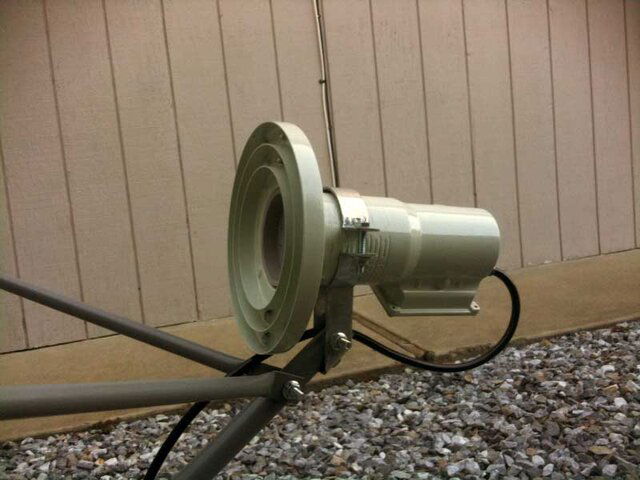Due to line of sight and neighborhood restrictions, my home system needs to be a little creative. A motorized 90cm dish and a fixed 1.2M dish in a clearing can see between the pine and oak trees 83w - 99w and a second location on the roof will soon add motorized GEOSATpro 90cm and 1.2m dishes for 101w - 139w.
A few months ago I had ground mounted the fixed GEOSATpro 1.2m on a NPRM for the 99w C-band PR/VI mux. Have enjoyed the east coast time offset for the networks and record the prime time block for time shift viewing. Previous testing on the 1.2M showed that C-band 95w and 91w satellites could be received in offset positions by removing the centered C-band LNBF and hand holding the LNBF into the correct position. Several transponders would provide SN of over 7db. The 91w satellite with the CW mux and the 41 radio stations could be received with plenty of threshold headroom Had a few days off so brought home an extra C-band LNBF, C-band clamp and 3 LNBF mount bracket and a DiSEqC 4x1 switch to add a 2nd LNBF to the mini-BUD.
Took about a 1/2 hour to assemble the offset bracket and properly position the clamp to hold the LNBF at the proper distance, Elevation and angle. First the bracket was loosely assembled to allow the clamp to be freely moved. Handheld the LNBF to determine the approximate position then moved the clamp into position to support the LNBF. Loosely clamped the LNBF and fine tuned the Elevation, offset distance, skew and focal distance.
Due to the lack of terrestrial interference at this location, I have found that both LNBFs perform best with no scalar. Have tested with both flat and offset scalar types and observe a significant drop in carrier to noise ratio and loss of threshold signals (example: 99w PR/VI mux drops from Signal Quality 70% to a 55% when attaching the flat scalar and to 50% when attaching an offset type. The scalar position is possible to be set at almost any point of the feedhorn. On the flat scalar even tried mounting behind the clamp with varied, but always decreased Signal Quality readings.
Quite happy with the results. On the centered LNBF for 99w, receive the VI/PR mux at 7.5db CN (70+% SQ reading on the microHD), 8.0dB on Lesea, 9dB on AFN (for radio station), 6.8dB on GDMX 6.x mux, 6dB on KCWY and barely above threshold on WAPA. On the Offset 91w LNBF receive 7db on CW mux, 7.2 on The Word mux and 9.5db on the audio mux. Going to try and optimize a little more as I would love to add Classic Arts or a certain movie service, but think I am dreaming as it probably isn't possible with this small reflector. The carriers are so low on the spectrum analyzer.

Wide Shot of Motorized GEOSATpro 90cm and fixed 1.2M
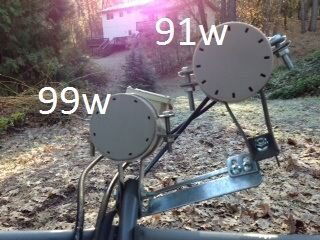
99w Centered and 91w Offset and raised
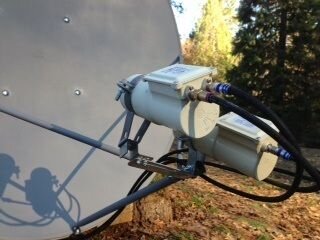
Centered 99w feeds 4x1 DiSEqC for main microHD system
Offset 91w feeds 4x1 DiSEqC for main microHD and 2nd output to HTPC for 24/7 audio channels for entire home listening.
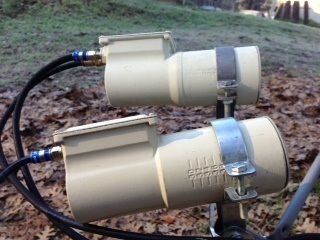
Adjustable LNBF bracket with C-band clamp
Will add 2nd clamp at rear of feedhorns for additional stability
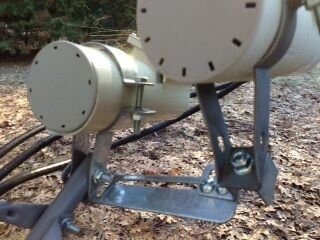
Additional photo of clamping assembly.
A few months ago I had ground mounted the fixed GEOSATpro 1.2m on a NPRM for the 99w C-band PR/VI mux. Have enjoyed the east coast time offset for the networks and record the prime time block for time shift viewing. Previous testing on the 1.2M showed that C-band 95w and 91w satellites could be received in offset positions by removing the centered C-band LNBF and hand holding the LNBF into the correct position. Several transponders would provide SN of over 7db. The 91w satellite with the CW mux and the 41 radio stations could be received with plenty of threshold headroom Had a few days off so brought home an extra C-band LNBF, C-band clamp and 3 LNBF mount bracket and a DiSEqC 4x1 switch to add a 2nd LNBF to the mini-BUD.
Took about a 1/2 hour to assemble the offset bracket and properly position the clamp to hold the LNBF at the proper distance, Elevation and angle. First the bracket was loosely assembled to allow the clamp to be freely moved. Handheld the LNBF to determine the approximate position then moved the clamp into position to support the LNBF. Loosely clamped the LNBF and fine tuned the Elevation, offset distance, skew and focal distance.
Due to the lack of terrestrial interference at this location, I have found that both LNBFs perform best with no scalar. Have tested with both flat and offset scalar types and observe a significant drop in carrier to noise ratio and loss of threshold signals (example: 99w PR/VI mux drops from Signal Quality 70% to a 55% when attaching the flat scalar and to 50% when attaching an offset type. The scalar position is possible to be set at almost any point of the feedhorn. On the flat scalar even tried mounting behind the clamp with varied, but always decreased Signal Quality readings.
Quite happy with the results. On the centered LNBF for 99w, receive the VI/PR mux at 7.5db CN (70+% SQ reading on the microHD), 8.0dB on Lesea, 9dB on AFN (for radio station), 6.8dB on GDMX 6.x mux, 6dB on KCWY and barely above threshold on WAPA. On the Offset 91w LNBF receive 7db on CW mux, 7.2 on The Word mux and 9.5db on the audio mux. Going to try and optimize a little more as I would love to add Classic Arts or a certain movie service, but think I am dreaming as it probably isn't possible with this small reflector. The carriers are so low on the spectrum analyzer.

Wide Shot of Motorized GEOSATpro 90cm and fixed 1.2M

99w Centered and 91w Offset and raised

Centered 99w feeds 4x1 DiSEqC for main microHD system
Offset 91w feeds 4x1 DiSEqC for main microHD and 2nd output to HTPC for 24/7 audio channels for entire home listening.

Adjustable LNBF bracket with C-band clamp
Will add 2nd clamp at rear of feedhorns for additional stability

Additional photo of clamping assembly.
Last edited:



